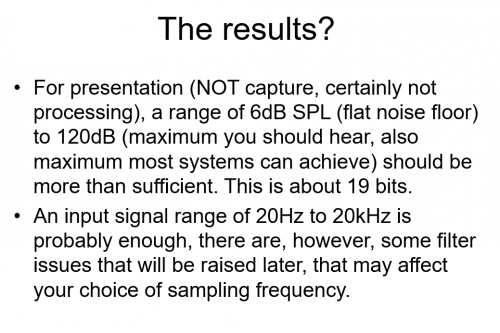71 dB
Headphoneus Supremus
Did you read what I wrote? It had nothing to do with the points you are making. Regardless, how do you know how much resolution those masters have? Do you even know how to compute that? If not, then I don't want you or anyone else in charge of truncating it to that amount. I can play the mastered format on my system thank you very much. Keep your hands away from my bits!
I read that you want original high res studio masters without anyone downsampling them to 16/44.1. Real life ADCs have dynamic range of about 20 bits and those bits aren't used optimally (that's the point of having extra bits in music production), so maybe there's 18 bits of "real resolution", but even that doesn't make it better than 16 bit, because nobody hears the difference in music listening. You'd have to listen to the loud parts in the evening and the go to sleep and in the morning listen to the silent parts and even then it would be a huge challenge. Totally impractical.
Nobody is touching your bits so please calm down. All we are trying to do is to convince you and others that high res digital audio doesn't offer anything but bigger usage of storage space. What comes to being able to "compute" things related to digital audio: Master's degree in electric engineering (majoring acoustics and signal prosessing) should help a lot with that.
Adding bits to increase dynamic range seems tempting, but every new bit is only half of the previous smallist one in significance (literally!!) so the relevance of adding bits dies away very quickly! In music listening 8 bits is not enough at all, 12 bits starts to be enough, 16 bits is overkill, 20 bits is OVERKILL and 24 bits is O V E R K I L L !!!! In your 24 bit music files the upper 14 bits are relevant and the lower 10 bits are waste of storage space.







